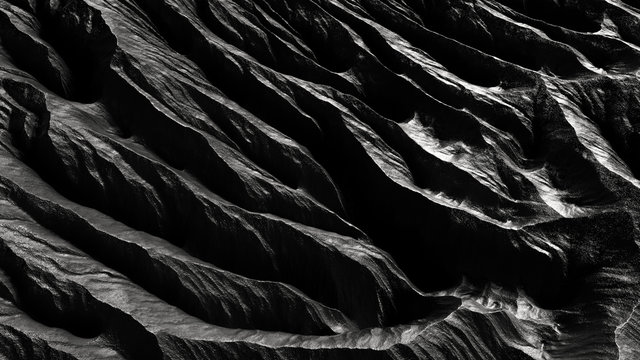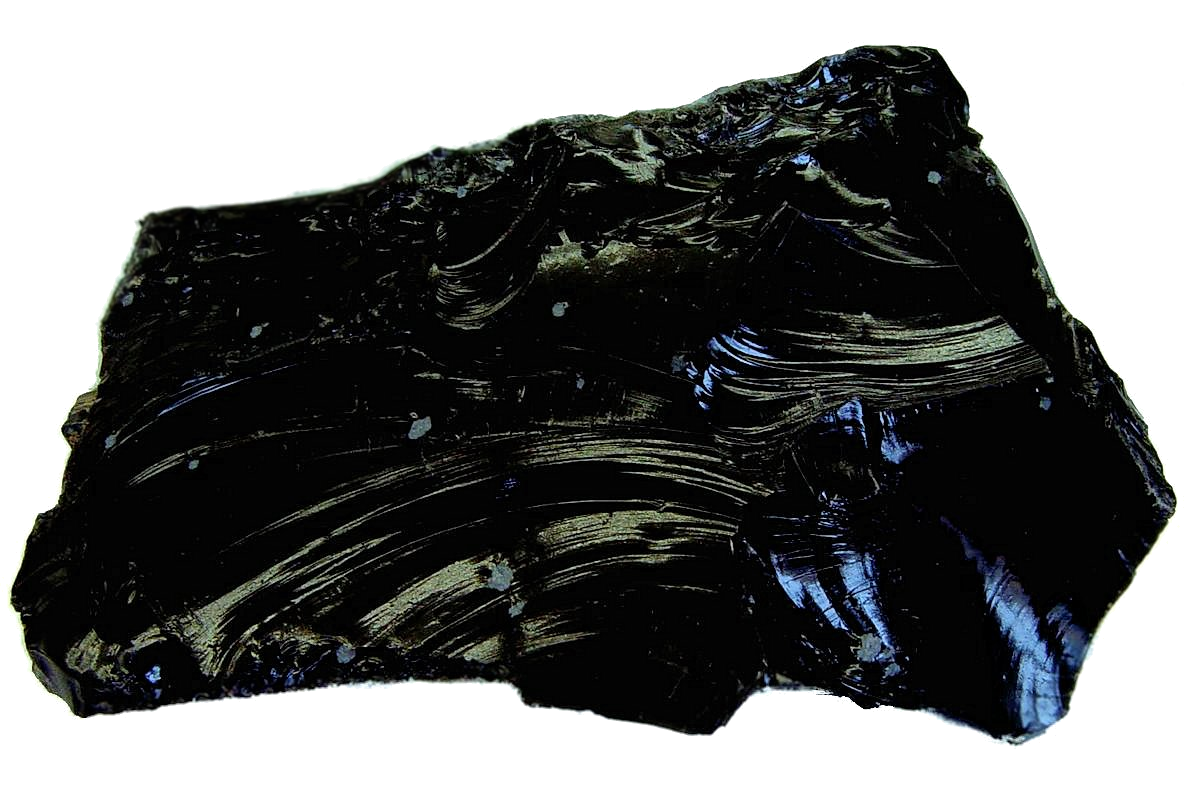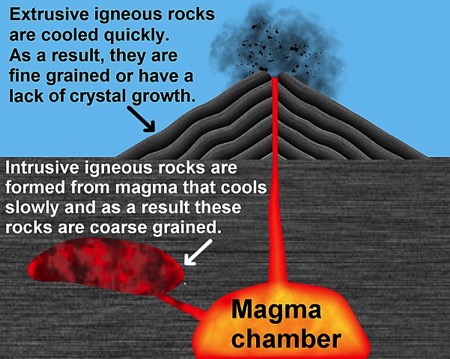Obsidian - A Volcanic Natural Glass
Obsidian is a type of volcanic glass that forms when lava extruded from a volcano cools swiftly and crystal development is low.
Author:Dr. Felix ChaosphereReviewer:Xander OddityApr 25, 202212 Shares607 Views

Obsidianis a type of volcanic glass that forms when lava extruded from a volcano cools swiftly and crystal development is low. It is a naturally occurring volcanic glass. It is composed of igneous rock.
How Is Obsidian Formed?
Obsidian is formed from felsic lava, which contains a high concentration of lighter elements such as silicon, oxygen, aluminum, sodium, and potassium, as well as heavier elements such as iron and manganese. A frequent location for obsidian is along the margins of rhyolitic lava flows, which are also known as obsidian flows. Because of the high concentration of silica in these flows, they have a high viscosity. The extreme viscosity of the lava prevents atoms from diffusing through it, which prevents the first stage (nucleation) in the production of mineral crystals from occurring. When combined with quick cooling, this leads to the formation of a natural glass from the lava.
Because obsidian is strong, brittle, and amorphous, it fractures with sharp edges when it is broken. In the past, it has been used to create cutting and piercing instruments, and it has even been employed experimentally as surgical scalpel blades in the field of surgery.
Origin
Obsidian, a volcanic glass discovered in Ethiopia by Romanexplorer Obsidius, is mentioned in Pliny the Elder's Natural History.
This occurs when felsic lava cools rapidly near the borders of a flow or dome, or when it cools rapidly in contact with water or air. Obsidian can form when felsic lava cools along a dike's edge.
Many scientists formerly believed tektites were obsidian from lunar volcanic eruptions, but this belief has faded.
Obsidian is a mineral-like glass that is not crystalline and whose composition is too changeable to be classified as a mineral. It is a mineraloid. Though obsidian is dark in color, like mafic rocks like basalt, its composition is strongly felsic.
Obsidian is primarily SiO2 (silicon dioxide), frequently 70% or more by weight. Granite and rhyolite are both crystalline rocks. Because obsidian is metastable (it devitrifies into fine-grained mineral crystals), obsidian older than Miocene is unusual. Old obsidians include Cretaceous welded tuff and Ordovician perlite partially devitrified. Water accelerates the transformation of obsidian. In spite of its low water content, newly created obsidian gradually hydrates when exposed to groundwater, yielding perlite.
The color of pure obsidian changes based on the impurities present. Brown to black coloration is caused by iron and other transition metals. Magnetite, an iron oxide, is commonly found in black obsidian. Obsidian is rarely colorless. In some stones, little white radially clustered cristobalite crystals (spherulites) in the black glass give a blotchy or snowflake pattern (snowflake obsidian). Obsidians may retain traces of lava bubbles aligned along strata formed as the molten rock flowed before cooling. These bubbles can generate a golden gloss (sheen obsidian). Magnetite nanoparticles create thin-film interference, giving fire obsidian an iridescent rainbow sheen. Rainbow obsidian from Mexico comprises aligned nanorods of hedenbergite that cause thin-film interference to produce rainbow striping.
What Is Obsidian Used For?
A type of glass knife, obsidian blades are formed from naturally occurring obsidian rather than synthetic glass and can be highly sharp. Obsidian blades are made from obsidian rather than synthetic glass and can be exceptionally sharp.
Some surgeons employ obsidian for the blades of scalpels, despite the fact that the substance has not been approved for use on people by the United States Food and Drug Administration (FDA).
As with any glass knife, a well-crafted obsidian blade has the potential to have a cutting edge that is several times sharper than a high-quality steel medical scalpel, due to the fact that the cutting edge of the blade is only about 3 nanometers thick.
When seen under a powerful enough microscope, the blades of all-metal knives have a jagged, uneven appearance; yet, obsidian blades remain smooth even when inspected with a high-powered electron microscope. The results of one study showed that rats exposed to obsidian incisions had lower levels of inflammatory cells as well as lower levels of granulation tissue after seven days, but the effects were no longer noticeable after twenty-one days. In addition to manufacturing surgical obsidian blades, Don Crabtree has written publications on the subject. Obsidian scalpels are already available for purchase for use in surgical procedures on laboratory animals.
The biggest disadvantage of obsidian blades as compared to metal blades is their brittleness, which limits the surgical applications for obsidian blades to a number of specialized usages where brittleness is not an issue.
Snowflake obsidian is used to carve this pig, which is 10 centimeters (4 inches) in length. Spherulites are the marks on the skin.
Obsidian is also utilized as a decorative stone and as a gemstone in some cultures.
Because of the way it is sliced, it has a distinct appearance depending on which direction you cut it: one direction is jet black, while the other is gleaming grey.
"Apache tears" are little circular obsidian nuggets that are commonly found embedded inside a grayish-white perlite matrix.
The video provided above is on Reddit. Check some of the comments below.
"Fun fact. I was touring South America and travelled to a volcanic crater with a lagoon about 20 years ago. I saw some small round black rocks and thought, “neat, obsidian!”
I picked one up and it squished between my fingers. I looked up as some sheep trotted by.
It was not, in fact, obsidian."
_NWmba
"I came across an obsidian boulder about 4 feet tall, 4 feet wide, 6 feet long doing my archaeology dissertation field work. It was pretty impressive. Typically very difficult to find as obsidian degrades by hydration fractures relatively quickly (in geological terms)."
_davehunt00
"Whoa! That isseriously impressive, maybe even genuinely awesome. Hydration fractures... does that mean from water ingress that occurs through formed fractures and temperature cycling over time or?"
_Quantum_Tangled
Conclusion
Since the 1970s, obsidian has been used to create plinths for audio turntables, such as the grayish-black SH-10B3 plinth from Technics.

Dr. Felix Chaosphere
Author
Dr. Felix Chaosphere, a renowned and eccentric psychiatrist, is a master of unraveling the complexities of the human mind. With his wild and untamed hair, he embodies the essence of a brilliant but unconventional thinker. As a sexologist, he fearlessly delves into the depths of human desire and intimacy, unearthing hidden truths and challenging societal norms.
Beyond his professional expertise, Dr. Chaosphere is also a celebrated author, renowned for his provocative and thought-provoking literary works. His written words mirror the enigmatic nature of his persona, inviting readers to explore the labyrinthine corridors of the human psyche.
With his indomitable spirit and insatiable curiosity, Dr. Chaosphere continues to push boundaries, challenging society's preconceived notions and inspiring others to embrace their own inner tumult.

Xander Oddity
Reviewer
Xander Oddity, an eccentric and intrepid news reporter, is a master of unearthing the strange and bizarre. With an insatiable curiosity for the unconventional, Xander ventures into the depths of the unknown, fearlessly pursuing stories that defy conventional explanation. Armed with a vast reservoir of knowledge and experience in the realm of conspiracies, Xander is a seasoned investigator of the extraordinary.
Throughout his illustrious career, Xander has built a reputation for delving into the shadows of secrecy and unraveling the enigmatic. With an unyielding determination and an unwavering belief in the power of the bizarre, Xander strives to shed light on the unexplained and challenge the boundaries of conventional wisdom. In his pursuit of the truth, Xander continues to inspire others to question the world around them and embrace the unexpected.
Latest Articles
Popular Articles

